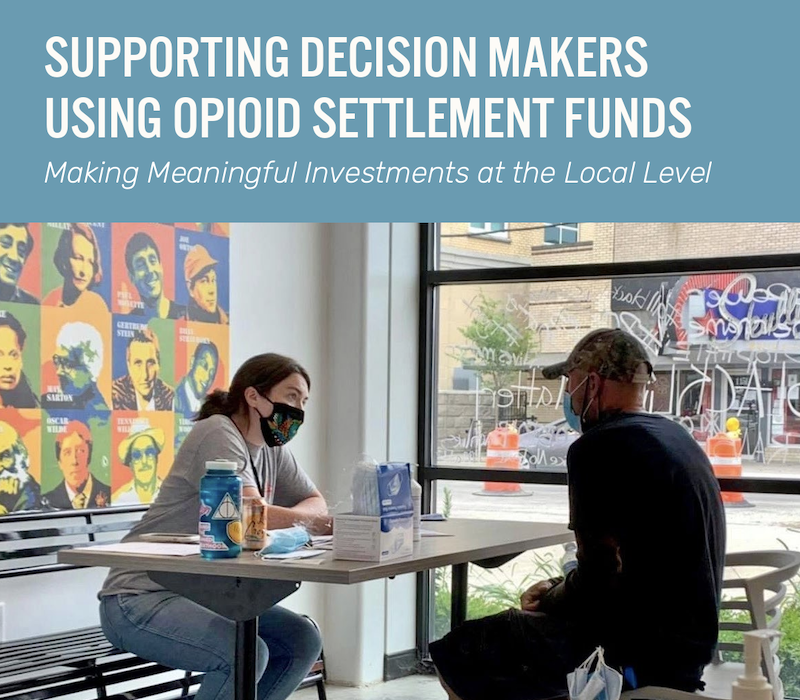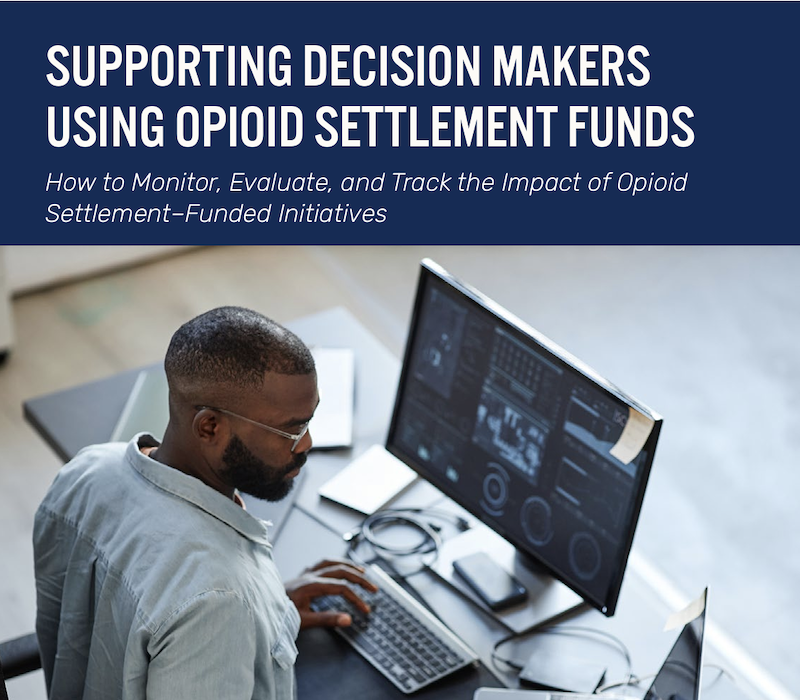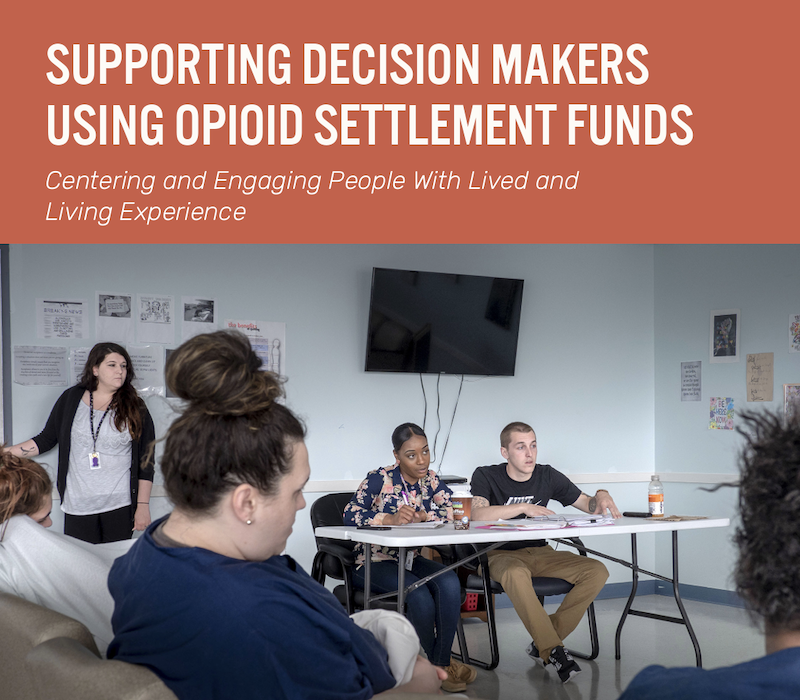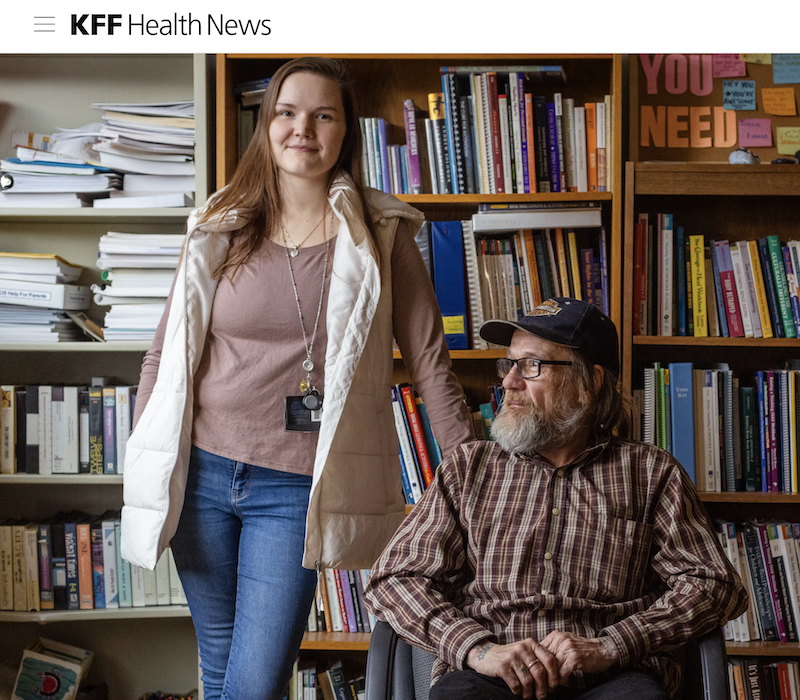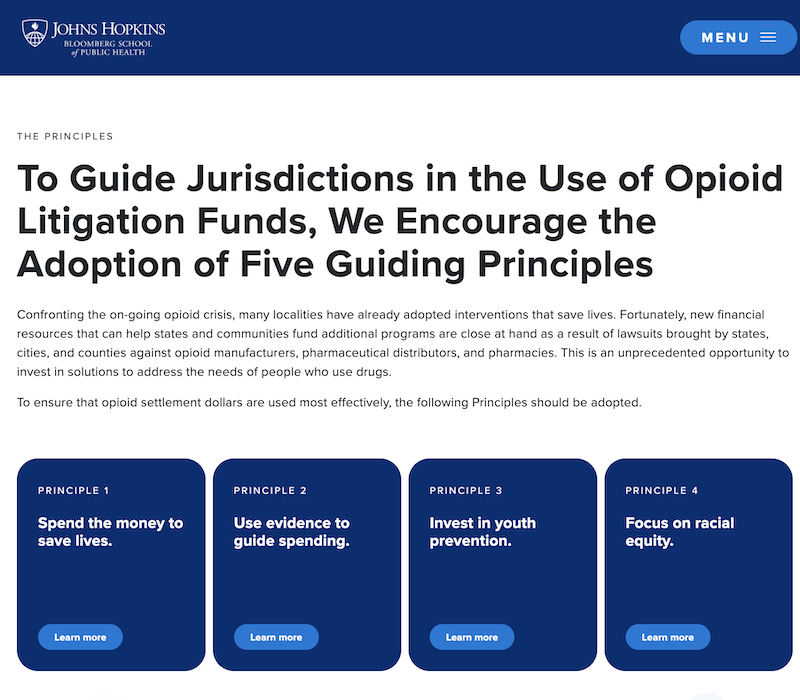Supporting local decision makers managing opioid settlement funds: A public health approach
August 2024
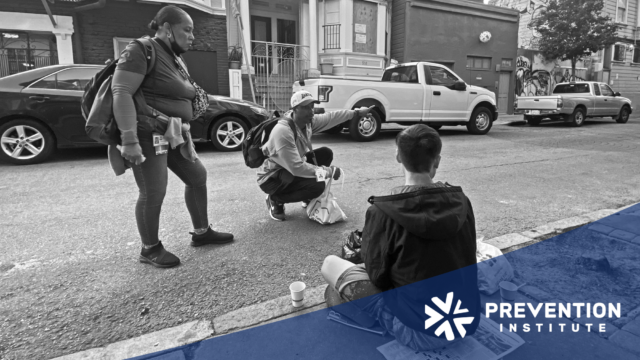
Opioid settlement funds have created an opportunity to strategically invest in evidence-based public health strategies that apply a multi-level, multi-sector prevention approach to strengthening communities and addressing the opioid epidemic. The resources listed here support local efforts to spend these funds wisely.
This set of online resources is intended to offer guidance to policymakers, health departments, community advocates, service providers, and other changemakers as they consider policies and programming to establish using opioid settlement dollars.
Featured Resources
Resources: Learning to Action
Identified resources are organized across a continuum of managing opioid settlement dollars. Please click one of the four blue tabs below to explore each resource category.
Suggested principles, frameworks, and core abatement strategies to consider throughout settlement fund decision-making
| Title | Type | Tags | Source | Suggested Audience | Description |
|---|---|---|---|---|---|
| A Roadmap for Opioid Settlement Funds: Supporting Communities & Ending the Overdose Crisis | Guidance Document | Primary Prevention Harm Reduction + Treatment Policy + Legislation | VOCAL-NY | Policymakers Advocates | Settlement fund priorities outlined by a national coalition of 133 advocacy and direct service organizations, including examples of “good” and “problematic” spending |
| Opioid Use Disorder: City Actions and Opportunities to Address the Epidemic | Guidance Document | Primary Prevention Harm Reduction + Treatment Policy + Legislation | National League of Cities | Policymakers | Highlights effective collaborative city efforts to address the opioid epidemic and highlights opportunities to expand those efforts |
| Multiplying the Impact of Opioid Settlement Funds by Investing in Primary Prevention | Journal Article | Primary Prevention Research Fund Allocation | Journal of Hospital Medicine | Policymakers Direct Service Providers | Describes primary prevention strategies medical institutions can implement with settlement funds, including economic opportunities, affordable housing, and capacity building |
| Primer on Spending Funds from the Opioid Litigation | Guidance Document | Primary Prevention Harm Reduction + Treatment Fund Allocation | Johns Hopkins Bloomberg School of Public Health | Policymakers | Helps identify evidence-based programs for each of the nine core abatement strategies described in the Johnson & Johnson settlement agreements |
| Equity Considerations for Local Health Departments on Opioid Settlement Funds | Guidance Document | Research Lived + Living Experience Policy + Legislation | Legal Action Center | Health Departments | A checklist to guide county and city health officials through decision-making and priority-setting on accessing and dispersing settlement funds, with a focus on health equity |
| Evidence-Based Strategies for Abatement of Harms from the Opioid Epidemic | Guidance Document | Research Harm Reduction + Treatment Policy + Legislation | Legal Action Center | Policymakers | Evidence-based recommendations for investments that will improve medical treatment, strengthen prevention and harm reduction programming, and address the legal and policy systems |
| Navigating Settlement Fund Decision-Making with Integrity, Transparency, and Accountability | Guidance Document | Fund Allocation | Johns Hopkins Bloomberg School of Public Health | Policymakers | Discusses the need for ethical standards and transparency in opioid litigation boards and commissions |
| National Opioid Settlement Dashboard: Your City, Your Funds | Guidance Document | Fund Allocation Harm Reduction + Treatment Primary Prevention | National League of Cities | Policymakers | Interactive tool that helps cities and counties estimate their expected amount of allocated settlement funds and data-backed investment recommendations |
| The Principles Quick Guide to Removing Policy Barriers | Guidance Document | Policy + Legislation | National Association of Counties | Policymakers Advocates | Describes how to conduct a formal review and amendment of policies that may otherwise limit the impact of opioid settlement investments |
| The Principles Quick Guide to Creating a Settlement Council | Guidance Document | Fund Allocation Lived + Living Experience | National Association of Counties | Policymakers | Describes how to create and manage a settlement council that works with local decision makers to decide how to best use opioid settlement dollars |
| The Principles Quick Guide to Conducting a Needs Assessment | Guidance Document | Fund Allocation Lived + Living Experience Research | National Association of Counties | Health Departments | Describes how to conduct a local needs assessment to guide opioid settlement dollar disbursement |
| Applying a Social Determinants of Health Approach to the Opioid Epidemic | Journal Article | Primary Prevention Lived + Living Experience Research | Health Promotion Practice | General | Describes the efforts of three Ohio counties to address the community conditions that increase the risk of unhealthy substance use and addiction |
| Tribal Principles | Guidance Document | Lived + Living Experience Harm Reduction+ Treatment Fund Allocation | John Hopkins Center for Indigenous Health | General | List of five principles to guide tribes and their partners in the use of opioid settlement funds |
| From the War on Drugs to Harm Reduction: Imagining a Just Overdose Crisis Response | Guidance Document | Primary Prevention Harm Reduction+ Treatment | FXB Center for Health and Human Rights at Harvard University | Policymakers Advocates | Offers 11 recommendations for policy makers and advocates on how to use settlement funds. Guided by principles around supporting the health and wellbeing of people who use substances and people with opioid dependence, and addressing the structural drivers of opioid use and dependence |
| Evidence-Based Strategies for Preventing Opioid Overdose: What’s Working in the United States | Guidance Document | Harm Reduction+ Treatment | U.S. Centers for Disease Control and Prevention | Health Departments Policymakers | A list of 10 evidence-based public health strategies that states and jurisdictions can implement to prevent overdose |
| Considerations When Engaging Native Americans and RFPs | Guidance Document | Lived + Living Experience Fund Allocation | Wassaja Carlos Montezuma Center for Native American Health | Policymakers Health Departments | Describes considerations for developing Requests for Proposals (RFPs) that involve Native American individuals or entities |
Example policies and programming implemented using settlement funding and information on harm reduction, treatment, and recovery services
| Title | Type | Tags | Source | Suggested Audience | Description |
|---|---|---|---|---|---|
| Opioids Solutions Center: Counties in Action | Guidance Document | Fund Allocation Harm Reduction + Treatment | National Association of Counties | Policymakers Health Departments | Describes how six counties nationwide are quickly and strategically employing settlement funds to save lives |
| 2023 State of the States: Legislative Roadmap for Reducing Overdose Deaths and Increasing Access to Treatment | Guidance Document | Harm Reduction + Treatment Policy + Legislation | Legislative Analysis and Public Policy Association | Policymakers Advocates | Outlines ten policy strategies that states can implement to reduce overdose deaths and increase access to substance use treatment |
| Boston Opioid Settlements Community Engagement Report | Guidance Document | Fund Allocation Lived + Living Experience | Boston Public Health Commission | Policymakers Health Departments | Describes the City of Boston’s process for gathering community and organizational input on how to use local opioid settlement funds |
| Advancing Health Equity Through County Opioid Abatement Strategies | Guidance Document | Harm Reduction + Treatment Lived + Living Experience Fund Allocation | National Association of Counties | Policymakers Health Departments | Case studies on five counties that are integrating opioid settlement funds into ongoing health equity initiatives |
| Engaging with People with Lived Experience in Opioid Settlement Decision-Making | Guidance Document | Lived + Living Experience | National Academy for State Health Policy | Policymakers Direct Service Providers | Summarizes strategies that states have adopted for engaging with people with lived and living experience in opioid settlement decision-making |
| Understanding Stigma Through the Lived Experiences of People With Opioid Use Disorder | Journal Article | Lived + Living Experience Research | Drug and Alcohol Dependence | General | Explores the lived experiences of people who were in recovery from opioid use disorder or a family member, with a focus on stigma |
| Whole Person Recovery From Substance Use Disorder: A Call for Research Examining a Dynamic Behavioral Ecological Model of Contexts Supportive of Recovery | Journal Article | Lived + Living Experience Research Primary Prevention | Addiction Research and Theory | General | Summarizes research that has considered broader environmental and policy influences on substance use and introduces a new theoretical model of recovery |
| Preventing Overdose and Reducing Drug-Related Harm: Policy and implementation guides for state and local change | Guidance Document | Harm Reduction + Treatment Policy + Legislation Primary Prevention | ChangeLab Solutions | Policymakers Health Departments | Eleven policy strategies and a roadmap to policy implementation that can advance equity and prioritize care over punishment |
| Harm Reduction Legal Project Resources | Guidance Document | Policy + Legislation Harm Reduction + Treatment | Network for Public Health Law | General | Resources to support organizations in understanding and navigating laws and regulations that hamper harm reduction initiatives |
| Aligning City, County and State Resources to Address the Opioid Epidemic | Guidance Document | Fund Allocation Policy + Legislation | National League of Cities | Policymakers | Summarizes key findings from the six-city 2018 Mayors’ Institute on Opioids, including common priorities and lessons learned |
| Five Questions for Counties Considering Harm Reduction as an Opioid Abatement Strategy | Guidance Document | Fund Allocation Harm Reduction + Treatment | National Association of Counties | Policymakers | Overview of various harm reduction initiatives implemented by counties in different policy contexts nationwide |
| Public Health Considerations for Strategies and Partnerships | Guidance Document | Harm Reduction + Treatment | U.S. Centers for Disease Control and Prevention | Health Departments Direct Service Providers | Provides examples of evidence-based and promising strategies that can help local communities prevent overdoses |
| About Overdose Data to Action (CDC) | Guidance Document | Harm Reduction + Treatment | U.S. Centers for Disease Control and Prevention | Health Departments | Presents a framework for integrating data on nonfatal and fatal overdoses and prevention strategies |
| Syringe Services Programs: A Technical Package of Effective Strategies and Approaches for Planning, Design, and Implementation | Guidance Document | Harm Reduction + Treatment | U.S. Centers for Disease Control and Prevention | Health Departments Direct Service Providers | Provides evidence of the effectiveness of strategies and approaches for supporting successful planning, design, implementation, and sustainability of syringe services programs |
| What You Should Know About Xylazine | Guidance Document | Harm Reduction + Treatment | U.S. Centers for Disease Control and Prevention | General | Describes the dangers of xylazine, a non-opioid sedative often found in combination with opioids, and related harm reduction strategies |
| Linking People with Opioid Use Disorder to Medication Treatment | Guidance Document | Harm Reduction + Treatment | U.S. Centers for Disease Control and Prevention | Direct Service Providers | Strategies to support linkage to opioid use disorder care for clinicians and service providers |
| A Stimulant Guide: Answers to Emerging Questions about Stimulants in the Context of the Overdose Epidemic in the United States | Guidance Document | Harm Reduction + Treatment Research | U.S. Centers for Disease Control and Prevention | Health Departments Direct Service Providers | Answers common questions about stimulants, stimulant use, stimulant overdose, and stimulant overdose prevention strategies |
| Engaging People with Lived Experience to Improve Federal Research, Policy, and Practice | Guidance Document | Lived + Living Experience | U.S. Department of Health and Human Services | Policymakers | Resources with lessons learned and key considerations from a range of methods for engaging people with lived and living experience in research, policy, and practice |
| Harm Reduction Framework | Guidance Document | Harm Reduction + Treatment | Substance Abuse and Mental Health Services Administration | Health Departments Direct Service Providers | A comprehensive framework that informs SAMHSA’s harm reduction activities and partnerships with other government and community partners |
| Opioid-Overdose Reduction Continuum of Care Approach (ORCCA) Practice Guide 2023 | Guidance Document | Harm Reduction + Treatment Lived + Living Experience | Substance Abuse and Mental Health Services Administration | Direct Service Providers Advocates | Includes guidance, resources, and insights on implementing strategies from the Opioid-Overdose Reduction Continuum of Care Approach to reduce opioid overdose deaths |
| Overdose Crisis Community Decision Tool | Guidance Document | Harm Reduction + Treatment Research | National Institutes of Health | Policymakers Health Departments | A decision-making tool that provides a custom list of evidence-based strategies matched to a community’s unique opioid overdose reduction needs and goals |
Information on monitoring and evaluating the uses and impact of opioid settlement funding, including example spending dashboards
| Title | Type | Tags | Source | Suggested Audience | Description |
|---|---|---|---|---|---|
| Strategic Prevention Framework | Guidance Document | Research | Substance Abuse and Mental Health Services Administration | Health Departments Direct Service Providers | Toolkit outlining a five-step planning process and two principles for preventing substance misuse and promoting mental health |
| Appalachia Opioid Remediation Database | Database | Fund Allocation | Appalachia Opioid Remediation | General | Database outlining how counties in the 13 states of Appalachia are managing and spending settlement funds |
| Indicators for Monitoring Opioid Litigation Spending | Guidance Document | Fund Allocation | Johns Hopkins Bloomberg School of Public Health and Vital Strategies | Policymakers | Interactive tool to guide counties and states in investing in effective overdose prevention strategies and monitoring how investments are reducing overdose risk |
| North Carolina Opioid Settlements: Local Spending Plans Dashboard | Database | Fund Allocation | North Carolina Opioid Settlements | General | Dashboard of local spending to address the opioid overdose epidemic, providing a strong example of data transparency and reporting |
| State Opioid Response Grant: Writing Goals and SMART Objectives | Guidance Document | Fund Allocation | West Virginia Department of Health and Human Resources | Policymakers | Offers guidance on writing program goals and objectives to keep opioid response activities strategic, focused, and organized |
| Opioid Measurement Toolkit: Leveraging Aligned Data and Measures to Sustain Opioid Settlement Fund Investments | Guidance Document | Fund Allocation | Duke University Margolis Institute for Health Policy | Policymakers Direct Service Providers | Outlines a practical approach for integrating settlement-funded interventions into accountable payment and whole-person care model structures |
| Specifying Monitoring and Evaluation Measures for Local Overdose Prevention and Response Strategies: A Toolkit | Guidance Document | Fund Allocation | National Association of County and City Health Officials | Health Departments Direct Service Providers | Provides concrete examples to guide organizations in monitoring and evaluating overdose prevention and response program progress and short-term outcomes |
| Opioid Settlement Waste, Fraud, Abuse, or Mismanagement Accountability | Database | Fund Allocation | Opioid Policy Institute | Policymakers Advocates | A crowdsourced database of problematic opioid settlement spending nationwide that seeks to enable advocacy and action |
| Localize This: How to Report on Your Community’s Opioid Settlement Spending | News Report | Fund Allocation | KFF Health News | Advocates General | KFF Health News and Shatterproof explain how they compiled a database of ways jurisdictions have spent opioid settlement funding and how it can help local reporters |
Legal and historical context for the national opioid settlements, including state-by-state breakdowns of funding allocation, expenditures, and decision-making structures
| Title | Type | Tags | Source | Suggested Audience | Description |
|---|---|---|---|---|---|
| Glossary of Terms | Guidance Document | Primary Prevention Harm Reduction + Treatment Lived + Living Experience | Prevention Institute | General | A glossary of key terms related to understanding, planning for, and implementing activities using opioid settlement funding |
| Guides for Community Advocates on the Opioid Settlements | Database | Fund Allocation | Christine Minhee and Vital Strategies | Advocates | A set of 51 state-specific guides analyzing total settlement funds and allocation, decision-making processes, and additional resources for community advocates |
| Payback: Tracking the Opioid Settlement Cash | Database | Fund Allocation | KFF Health News | General | A hub for national news on opioid settlements and interactive tools to find information on state/local settlement payouts and state decision-making bodies |
| State Opioid Settlement Spending Decisions | Database | Fund Allocation | National Academy for State Health Policy | General | Provides an overview of how different states were deciding to allocate settlement funds as of May 2024 |
| A Quick “How-To” Guide for Understanding Opioid Settlements State-to-State | Guidance Document | Policy + Legislation | National Association of County and City Health Officials | General | A guide to opioid settlements, including how to find out about state-specific use of settlement funds and resources for community members, local decision-makers, and service providers to learn more |
| Opioid Settlement Dollars: A Breakdown of the Process and What it Means for Your Work in Overdose Prevention | Guidance Document | Policy + Legislation | Christine Minhee, National Overdose Prevention Network, & Dialogue4Health | Policymakers | A set of presentation slides providing a summary of opioid settlements and states’ spending plans, the settlement agreement’s contractual protections and opportunities for advocacy, and an analysis of the Exhibit E list of approved opioid remediation uses |
| Opioid Settlement Fund Grantmaking Opportunities Available for Community Organizations Nationwide | Guidance Document | Fund Allocation | Christine Minhee and Legal Action Center | Advocates | 51-state collection of opioid settlement community grant portals and request-for-proposal announcements, with a focus on accessibility of funds to community-based organizations |
| Official Tribal Opioids Settlement Website | Guidance Document | Policy + Legislation | BrownGreer PLC | General | The official site for information on Tribal Opioid Settlements, including the history and current status of the lawsuits, announcements, and information on how tribes can receive and use funds |
| FAQ & Explanatory Charts – National Opioids Settlement | Guidance Document | Policy + Legislation | Plaintiffs’ Executive Committee | General | The official site for the national opioids settlements, with the latest updates on ongoing litigation and links to relevant legal documents |
| Opioid Settlement Fund Landscape Report – Summary of Findings | Guidance Document | Policy + Legislation Lived + Living Experience Fund Allocation | Drexel University Dornsife School of Public Health, Big Cities Health Coalition and Prevention Institute | General | Snapshot of findings from a Winter 2023 survey and analysis of planning, processes, opportunities, and challenges related to the use of opioid settlement funds in states and local jurisdictions |
| Opioid Settlement Fund Landscape Report | Guidance Document | Policy + Legislation Lived + Living Experience Fund Allocation | Drexel University Dornsife School of Public Health, Big Cities Health Coalition and Prevention Institute | General | Analysis of planning, processes, opportunities, and challenges related to the use of opioid settlement funds in states and local jurisdictions conducted in Winter 2023 |
| Meet the People Deciding How to Spend $50 Billion in Opioid Settlement Cash | News Report | Lived + Living Experience Policy + Legislation Fund Allocation | KFF Health News | General | A database that describes the makeup and scope of power of state councils deciding how opioid settlement dollars are spent |
| How Settlement Dollars Advance City and County Opioid Abatement | Guidance Document | Fund Allocation | National League of Cities, National Association of Counties | Policymakers | Describes trends in opioid settlement fund allocation nationwide and highlights opportunities for cities and counties to collaborate in deploying these funds for maximum impact |
Planning Guidance
Planning Guidance
Suggested principles, frameworks, and core abatement strategies to consider throughout settlement fund decision-making
Type: Guidance Document
Tags: Primary Prevention, Harm Reduction + Treatment, Policy + Legislation
Source: VOCAL-NY
Suggested Audience: Policymakers, Advocates
Description: Settlement fund priorities outlined by a national coalition of 133 advocacy and direct service organizations, including examples of “good” and “problematic” spending
Type: Guidance Document
Tags: Primary Prevention, Harm Reduction + Treatment, Policy + Legislation
Source: National League of Cities
Suggested Audience: Policymakers
Description: Highlights effective collaborative city efforts to address the opioid epidemic and highlights opportunities to expand those efforts
Type: Journal Article
Tags: Primary Prevention, Research, Fund Allocation
Source: Journal of Hospital Medicine
Suggested Audience: Policymakers, Direct Service Providers
Description: Describes primary prevention strategies medical institutions can implement with settlement funds, including economic opportunities, affordable housing, and capacity building
Type: Guidance Document
Tags: Primary Prevention, Harm Reduction + Treatment, Fund Allocation
Source: Johns Hopkins Bloomberg School of Public Health
Suggested Audience: Policymakers
Description: Helps identify evidence-based programs for each of the nine core abatement strategies described in the Johnson & Johnson settlement agreements
Type: Guidance Document
Tags: Research, Lived + Living Experience, Policy + Legislation
Source: Legal Action Center
Suggested Audience: Health Departments
Description: A checklist to guide county and city health officials through decision-making and priority-setting on accessing and dispersing settlement funds, with a focus on health equity
Type: Guidance Document
Tags: Research, Harm Reduction + Treatment, Policy + Legislation
Source: Legal Action Center
Suggested Audience: Policymakers
Description: Evidence-based recommendations for investments that will improve medical treatment, strengthen prevention and harm reduction programming, and address the legal and policy systems
Type: Guidance Document
Tags: Fund Allocation
Source: Johns Hopkins Bloomberg School of Public Health
Suggested Audience: Policymakers
Description: Discusses the need for ethical standards and transparency in opioid litigation boards and commissions
Type: Guidance Document
Tags: Fund Allocation, Harm Reduction + Treatment, Primary Prevention
Source: National League of Cities
Suggested Audience: Policymakers
Description: Interactive tool that helps cities and counties estimate their expected amount of allocated settlement funds and data-backed investment recommendations
Type: Guidance Document
Tags: Policy + Legislation
Source: National Association of Counties
Suggested Audience: Policymakers, Advocates
Description: Describes how to conduct a formal review and amendment of policies that may otherwise limit the impact of opioid settlement investments
Type: Guidance Document
Tags: Fund Allocation, Lived + Living Experience
Source: National Association of Counties
Suggested Audience: Policymakers
Description: Describes how to create and manage a settlement council that works with local decision makers to decide how to best use opioid settlement dollars
Type: Guidance Document
Tags: Fund Allocation, Lived + Living Experience, Research
Source: National Association of Counties
Suggested Audience: Health Departments
Description: Describes how to conduct a local needs assessment to guide opioid settlement dollar disbursement
Type: Journal Article
Tags: Primary Prevention, Lived + Living Experience, Research
Source: Health Promotion Practice
Suggested Audience: General
Description: Describes the efforts of three Ohio counties to address the community conditions that increase the risk of unhealthy substance use and addiction
Type: Guidance Document
Tags: Lived + Living Experience, Harm Reduction + Treatment, Fund Allocation
Source: John Hopkins Center for Indigenous Health
Suggested Audience: General
Description: List of five principles to guide tribes and their partners in the use of opioid settlement funds
Type: Guidance Document
Tags: Primary Prevention, Lived + Living Experience
Source: FXB Center for Health and Human Rights at Harvard University
Suggested Audience: Policymakers, Advocates
Description: Offers 11 recommendations for policy makers and advocates on how to use settlement funds. Guided by principles around supporting the health and wellbeing of people who use substances and people with opioid dependence, and addressing the structural drivers of opioid use and dependence
Type: Guidance Document
Tags: Harm Reduction + Treatment
Source: U.S. Centers for Disease Control and Prevention
Suggested Audience: Health Departments, Policymakers
Description: A list of 10 evidence-based public health strategies that states and jurisdictions can implement to prevent overdose
Type: Guidance Document
Tags: Lived + Living Experience, Fund Allocation
Source: Wassaja Carlos Montezuma Center for Native American Health
Suggested Audience: Policymakers, Health Departments
Description: Describes considerations for developing Requests for Proposals (RFPs) that involve Native American individuals or entities
Implementation Strategies
Implementation Strategies
Example policies and programming implemented using settlement funding and information on harm reduction, treatment, and recovery services
Type: Guidance Document
Tags: Fund Allocation, Harm Reduction + Treatment
Source: National Association of Counties
Suggested Audience: Policymakers, Health Departments
Description: Describes how six counties nationwide are quickly and strategically employing settlement funds to save lives
Type: Guidance Document
Tags: Harm Reduction + Treatment, Policy + Legislation
Source: Legislative Analysis and Public Policy Association
Suggested Audience: Policymakers, Advocates
Description: Outlines ten policy strategies that states can implement to reduce overdose deaths and increase access to substance use treatment
Type: Guidance Document
Tags: Fund Allocation, Lived + Living Experience
Source: Boston Public Health Commission
Suggested Audience: Policymakers, Health Departments
Description: Describes the City of Boston’s process for gathering community and organizational input on how to use local opioid settlement funds
Type: Guidance Document
Tags: Harm Reduction + Treatment, Lived + Living Experience, Fund Allocation
Source: National Association of Counties
Suggested Audience: Policymakers, Health Departments
Description: Case studies on five counties that are integrating opioid settlement funds into ongoing health equity initiatives
Type: Guidance Document
Tags: Lived + Living Experience
Source: National Academy for State Health Policy
Suggested Audience: Policymakers, Direct Service Providers
Description: Summarizes strategies that states have adopted for engaging with people with lived and living experience in opioid settlement decision-making
Type: Journal Article
Tags: Lived + Living Experience, Research
Source: Drug and Alcohol Dependence
Suggested Audience: General
Description: Explores the lived experiences of people who were in recovery from opioid use disorder or a family member, with a focus on stigma
Type: Journal Article
Tags: Lived + Living Experience, Research, Primary Prevention
Source: Addiction Research and Theory
Suggested Audience: General
Description: Summarizes research that has considered broader environmental and policy influences on substance use and introduces a new theoretical model of recovery
Type: Guidance Document
Tags: Harm Reduction + Treatment, Policy + Legislation, Primary Prevention
Source: ChangeLab Solutions
Suggested Audience: Policymakers, Health Departments
Description: Eleven policy strategies and a roadmap to policy implementation that can advance equity and prioritize care over punishment
Type: Guidance Document
Tags: Policy + Legislation, Harm Reduction + Treatment
Source: Network for Public Health Law
Suggested Audience: General
Description: Resources to support organizations in understanding and navigating laws and regulations that hamper harm reduction initiatives
Type: Guidance Document
Tags: Fund Allocation, Policy + Legislation
Source: National League of Cities
Suggested Audience: Policymakers
Description: Summarizes key findings from the six-city 2018 Mayors’ Institute on Opioids, including common priorities and lessons learned
Type: Guidance Document
Tags: Fund Allocation, Harm Reduction + Treatment
Source: National Association of Counties
Suggested Audience: Policymakers
Description: Overview of various harm reduction initiatives implemented by counties in different policy contexts nationwide
Type: Guidance Document
Tags: Harm Reduction + Treatment
Source: U.S. Centers for Disease Control and Prevention
Suggested Audience: Health Departments, Direct Service Providers
Description: Provides examples of evidence-based and promising strategies that can help local communities prevent overdoses
Type: Guidance Document
Tags: Harm Reduction + Treatment
Source: U.S. Centers for Disease Control and Prevention
Suggested Audience: Health Departments
Description: Presents a framework for integrating data on nonfatal and fatal overdoses and prevention strategies
Type: Guidance Document
Tags: Harm Reduction + Treatment
Source: U.S. Centers for Disease Control and Prevention
Suggested Audience: Health Departments, Direct Service Providers
Description: Provides evidence of the effectiveness of strategies and approaches for supporting successful planning, design, implementation, and sustainability of syringe services programs
Type: Guidance Document
Tags: Harm Reduction + Treatment
Source: U.S. Centers for Disease Control and Prevention
Suggested Audience: General
Description: Describes the dangers of xylazine, a non-opioid sedative often found in combination with opioids, and related harm reduction strategies
Type: Guidance Document
Tags: Harm Reduction + Treatment
Source: U.S. Centers for Disease Control and Prevention
Suggested Audience: Direct Service Providers
Description: Strategies to support linkage to opioid use disorder care for clinicians and service providers
Type: Guidance Document
Tags: Harm Reduction + Treatment, Research
Source: U.S. Centers for Disease Control and Prevention
Suggested Audience: Health Departments, Direct Service Providers
Description: Answers common questions about stimulants, stimulant use, stimulant overdose, and stimulant overdose prevention strategies
Type: Guidance Document
Tags: Lived + Living Experience
Source: U.S. Department of Health and Human Services
Suggested Audience: Policymakers
Description: Resources with lessons learned and key considerations from a range of methods for engaging people with lived and living experience in research, policy, and practice
Type: Guidance Document
Tags: Harm Reduction + Treatment
Source: Substance Abuse and Mental Health Services Administration
Suggested Audience: Health Departments, Direct Service Providers
Description: A comprehensive framework that informs SAMHSA’s harm reduction activities and partnerships with other government and community partners
Type: Guidance Document
Tags: Harm Reduction + Treatment, Lived + Living Experience
Source: Substance Abuse and Mental Health Services Administration
Suggested Audience: Direct Service Providers, Advocates
Description: Includes guidance, resources, and insights on implementing strategies from the Opioid-Overdose Reduction Continuum of Care Approach to reduce opioid overdose deaths
Type: Guidance Document
Tags: Harm Reduction + Treatment, Research
Source: National Institutes of Health
Suggested Audience: Policymakers, Health Departments
Description: A decision-making tool that provides a custom list of evidence-based strategies matched to a community’s unique opioid overdose reduction needs and goals
Evaluation + Sustainability
Evaluation + Sustainability
Information on monitoring and evaluating the uses and impact of opioid settlement funding, including example spending dashboards
Type: Guidance Document
Tags: Research
Source: Substance Abuse and Mental Health Services Administration
Suggested Audience: Health Departments, Direct Service Providers
Description: Toolkit outlining a five-step planning process and two principles for preventing substance misuse and promoting mental health
Type: Database
Tags: Fund Allocation
Source: Appalachia Opioid Remediation
Suggested Audience: General
Description: Database outlining how counties in the 13 states of Appalachia are managing and spending settlement funds
Type: Guidance Document
Tags: Fund Allocation
Source: Johns Hopkins Bloomberg School of Public Health and Vital Strategies
Suggested Audience: Policymakers
Description: Interactive tool to guide counties and states in investing in effective overdose prevention strategies and monitoring how investments are reducing overdose risk
Type: Database
Tags: Fund Allocation
Source: North Carolina Opioid Settlements
Suggested Audience: General
Description: Dashboard of local spending to address the opioid overdose epidemic, providing a strong example of data transparency and reporting
Type: Guidance Document
Tags: Fund Allocation
Source: West Virginia Department of Health and Human Resources
Suggested Audience: Policymakers
Description: Offers guidance on writing program goals and objectives to keep opioid response activities strategic, focused, and organized
Type: Guidance Document
Tags: Fund Allocation
Source: Duke University Margolis Institute for Health Policy
Suggested Audience: Policymakers, Direct Service Providers
Description: Outlines a practical approach for integrating settlement-funded interventions into accountable payment and whole-person care model structures
Type: Guidance Document
Tags: Fund Allocation
Source: National Association of County and City Health Officials (NACCHO)
Suggested Audience: Health Departments, Direct Service Providers
Description: Provides concrete examples to guide organizations in monitoring and evaluating overdose prevention and response program progress and short-term outcomes
Type: Database
Tags: Fund Allocation
Source: Opioid Policy Institute
Suggested Audience: Policymakers, Advocates
Description: A crowdsourced database of problematic opioid settlement spending nationwide that seeks to enable advocacy and action
Type: News Report
Tags: Fund Allocation
Source: KFF Health News
Suggested Audience: Advocates, General
Description: KFF Health News and Shatterproof explain how they compiled a database of ways jurisdictions have spent opioid settlement funding and how it can help local reporters
Background Info
Background Info
Legal and historical context for the national opioid settlements, including state-by-state breakdowns of funding allocation, expenditures, and decision-making structures
Type: Guidance Document
Tags: Primary Prevention, Harm Reduction + Treatment, Lived + Living Experience
Source: Prevention Institute
Suggested Audience: General
Description: A glossary of key terms related to understanding, planning for, and implementing activities using opioid settlement funding
Type: Database
Tags: Fund Allocation
Source: Christine Minhee and Vital Strategies
Suggested Audience: Advocates
Description: A set of 51 state-specific guides analyzing total settlement funds and allocation, decision-making processes, and additional resources for community advocates
Type: Database
Tags: Fund Allocation
Source: KFF Health News
Suggested Audience: General
Description: A hub for national news on opioid settlements and interactive tools to find information on state/local settlement payouts and state decision-making bodies
Type: Database
Tags: Fund Allocation
Source: National Academy for State Health Policy
Suggested Audience: Policymakers
Description: Provides an overview of how different states were deciding to allocate settlement funds as of May 2024
Type: Guidance Document
Tags: Policy + Legislation
Source: National Association of County and City Health Officials
Suggested Audience: General
Description: A guide to opioid settlements, including how to find out about state-specific use of settlement funds and resources for community members, local decision-makers, and service providers to learn more
Type: Guidance Document
Tags: Policy + Legislation
Source: Christine Minhee, National Overdose Prevention Network, & Dialogue4Health
Suggested Audience: Policymakers
Description: A set of presentation slides providing a summary of opioid settlements and states’ spending plans, the settlement agreement’s contractual protections and opportunities for advocacy, and an analysis of the Exhibit E list of approved opioid remediation uses
Type: Guidance Document
Tags: Fund Allocation
Source: Christine Minhee and Legal Action Center
Suggested Audience: Advocates
Description: 51-state collection of opioid settlement community grant portals and request-for-proposal announcements, with a focus on accessibility of funds to community-based organizations
Type: Guidance Document
Tags: Policy + Legislation
Source: BrownGreer PLC
Suggested Audience: General
Description: The official site for information on Tribal Opioid Settlements, including the history and current status of the lawsuits, announcements, and information on how tribes can receive and use funds
Type: Guidance Document
Tags: Policy + Legislation
Source: Plaintiffs’ Executive Committee
Suggested Audience: General
Description: The official site for the national opioids settlements, with the latest updates on ongoing litigation and links to relevant legal documents
Type: Guidance Document
Tags: Policy + Legislation, Lived + Living Experience, Fund Allocation
Source: Big Cities Health Coalition and Prevention Institute
Suggested Audience: General
Description: Snapshot of findings from a Winter 2023 survey and analysis of planning, processes, opportunities, and challenges related to the use of opioid settlement funds in states and local jurisdictions
Type: Guidance Document
Tags: Policy + Legislation, Lived + Living Experience, Fund Allocation
Source: Drexel University Dornsife School of Public Health, Big Cities Health Coalition and Prevention Institute
Suggested Audience: General
Description: Analysis of planning, processes, opportunities, and challenges related to the use of opioid settlement funds in states and local jurisdictions conducted in Winter 2023
Type: News Report
Tags: Lived + Living Experience, Policy + Legislation, Fund Allocation
Source: KFF Health News
Suggested Audience: General
Description: A database that describes the makeup and scope of power of state councils deciding how opioid settlement dollars are spent
Type: Guidance Document
Tags: Fund Allocation
Source: National League of Cities, National Association of Counties
Suggested Audience: Policymakers
Description: Describes trends in opioid settlement fund allocation nationwide and highlights opportunities for cities and counties to collaborate in deploying these funds for maximum impact
Webinars
Scroll below to find recordings from the “Supporting Decision Makers Using Opioid Settlement Funds” webinar series.
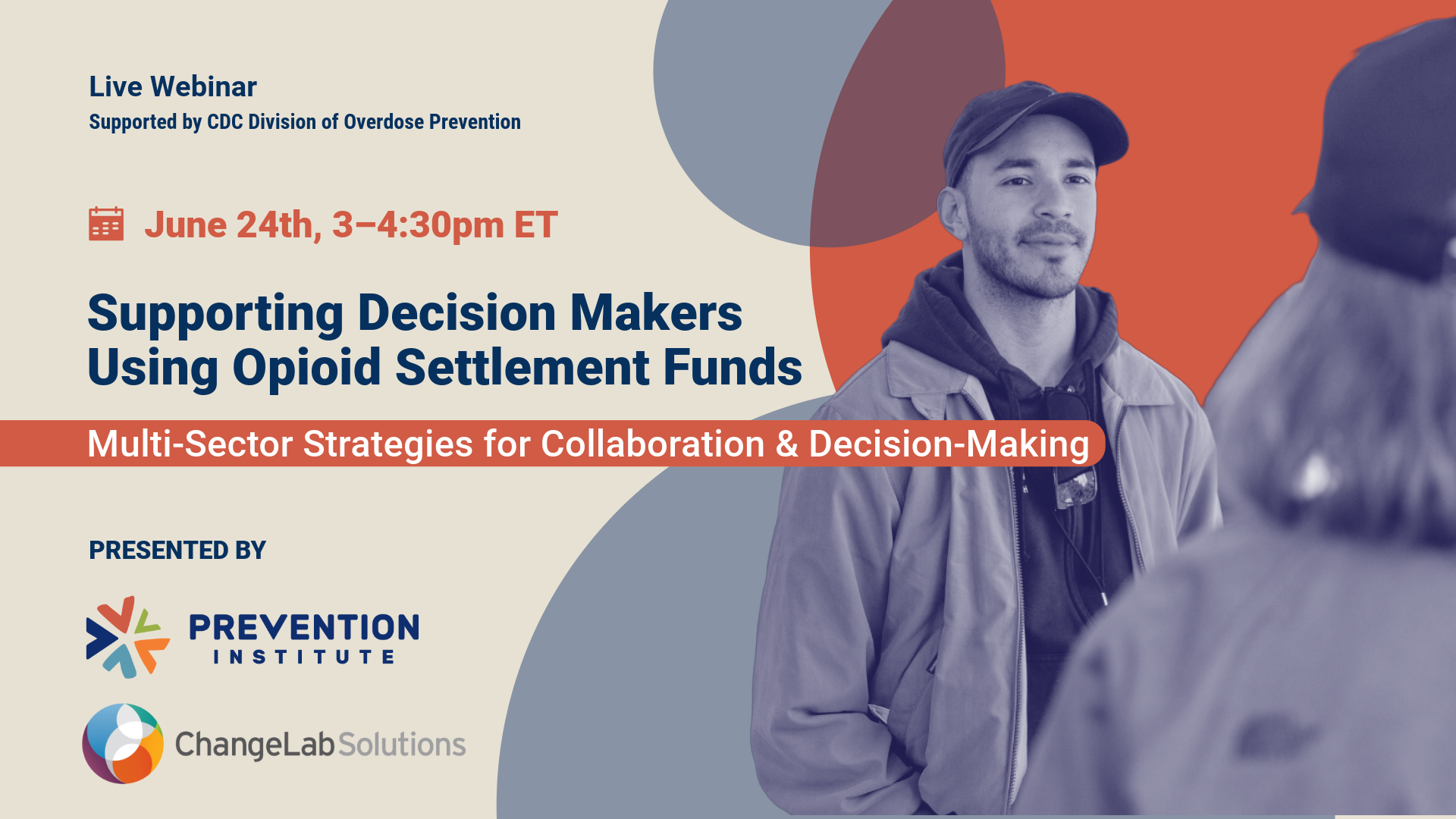
Webinar 6: Multi-Sector Strategies for Collaboration and Decision-Making (June 24, 2025) – read a summary
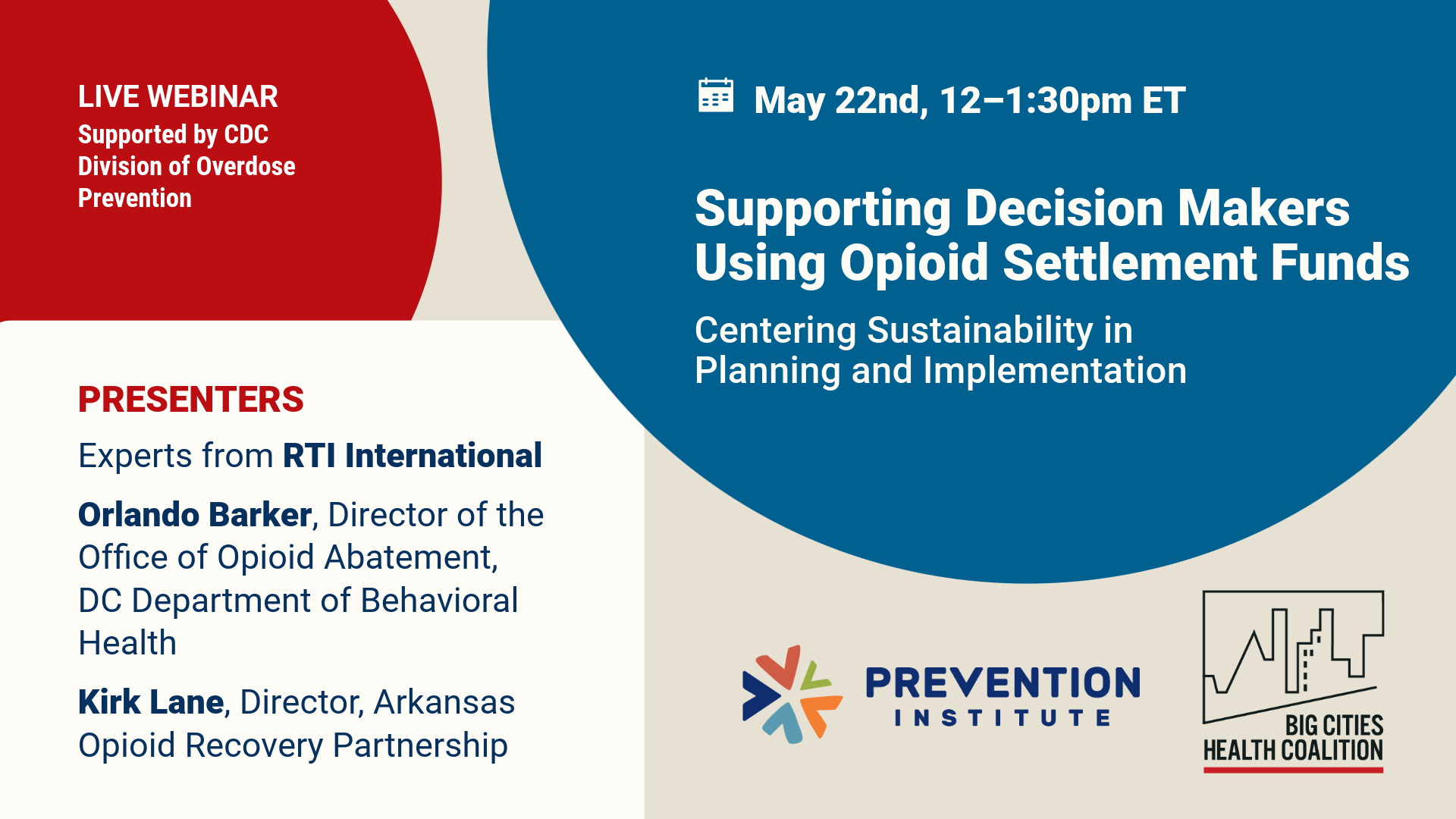
Webinar 5: Centering Sustainability in Planning and Implementation (May 22, 2025) – read a summary
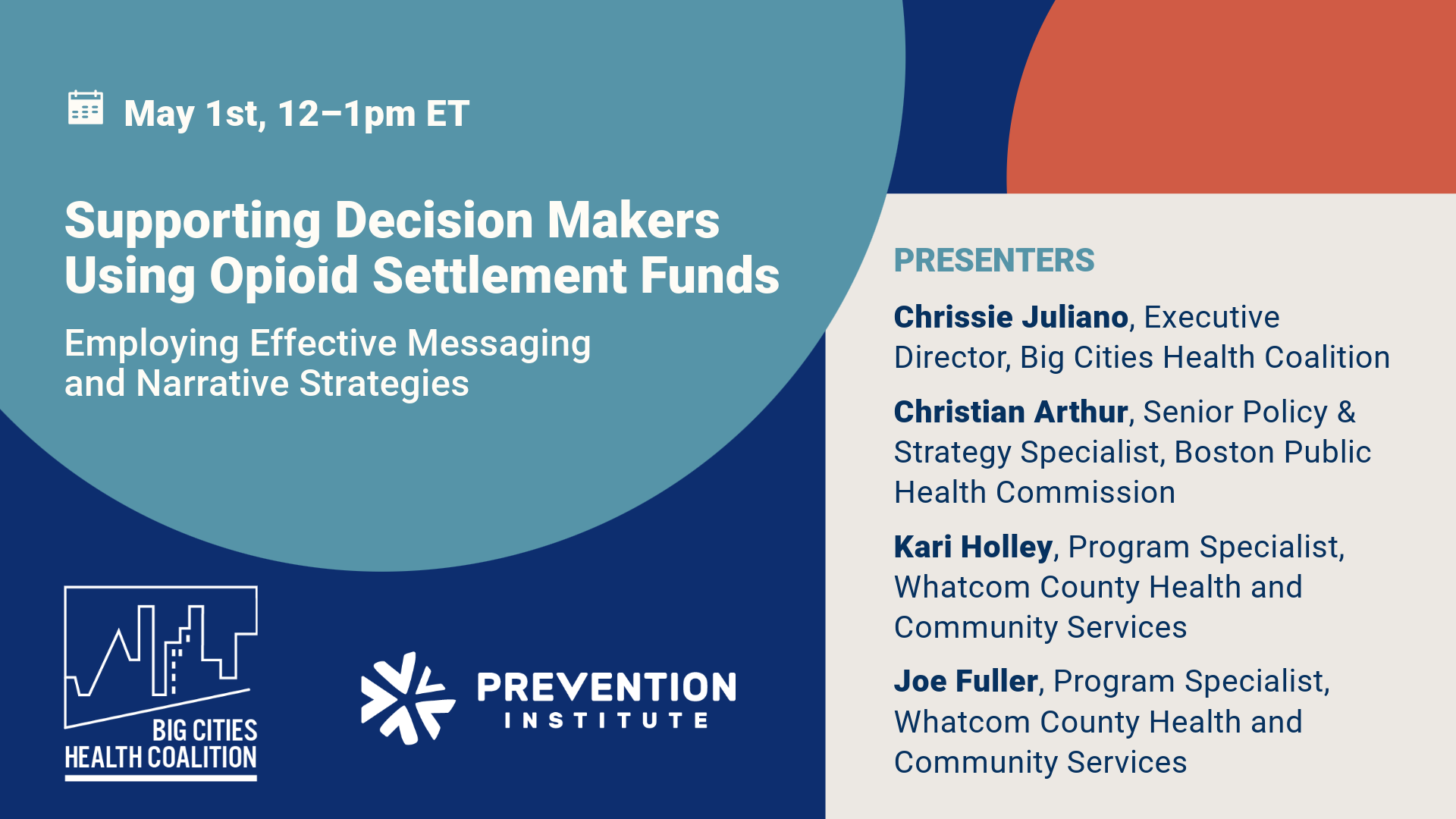
Webinar 4: Employing Effective Messaging and Narrative Strategies (May 1, 2025) – read a summary
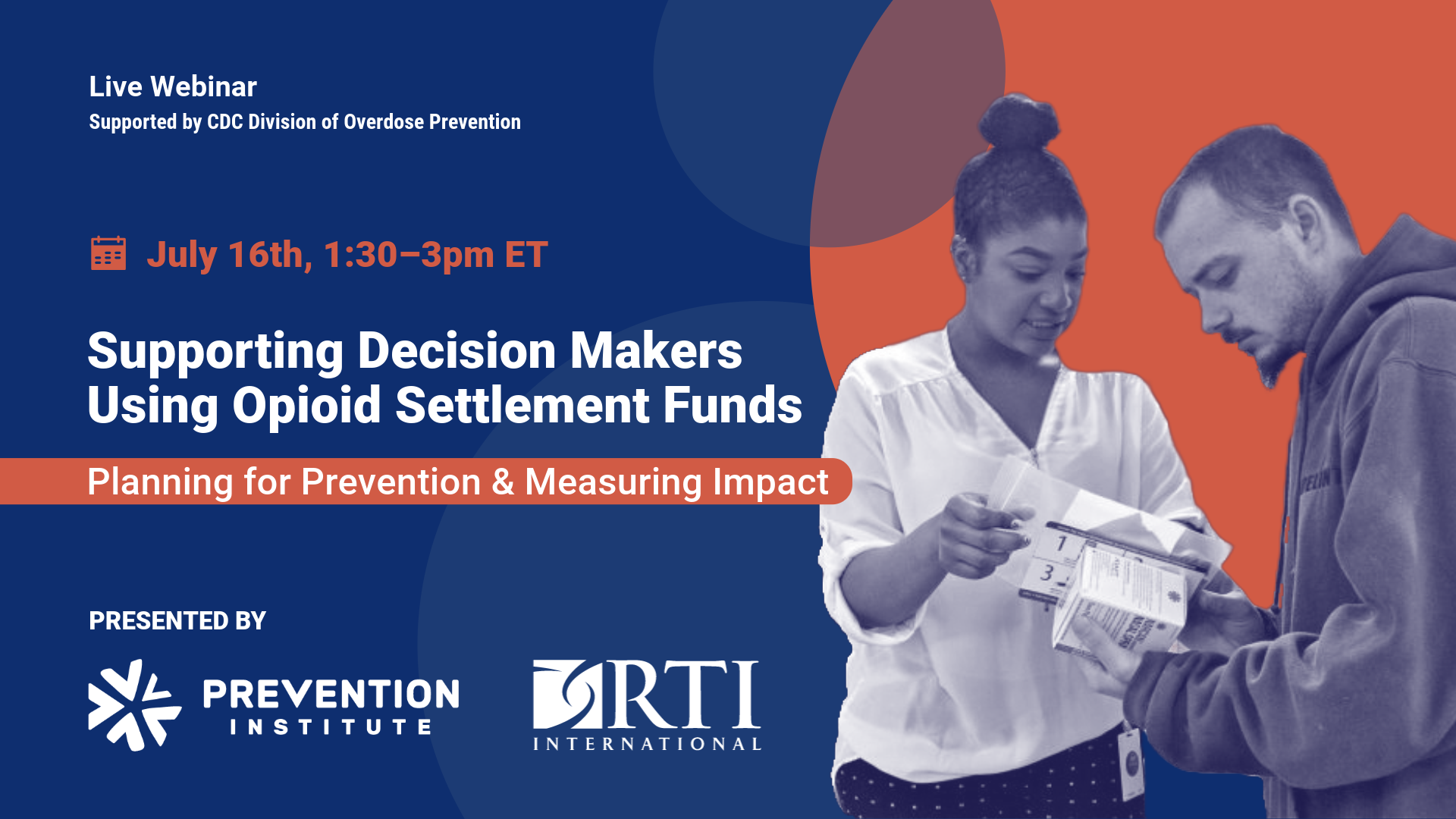
Webinar 3: Planning for Prevention and Measuring Impact (July 16, 2024)
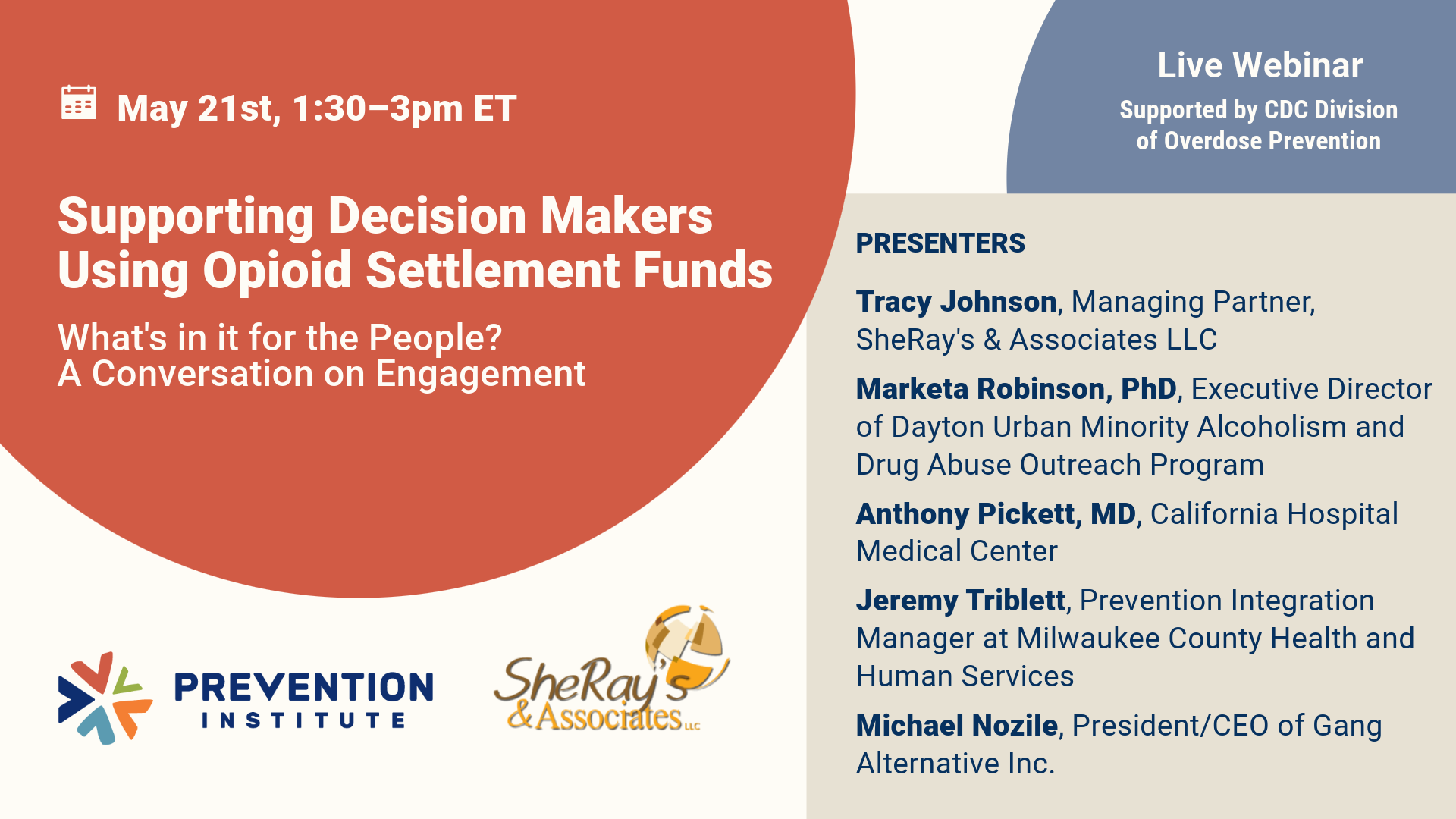
Webinar 2: What’s In It For the People? A Conversation on Engagement (May 21, 2024)
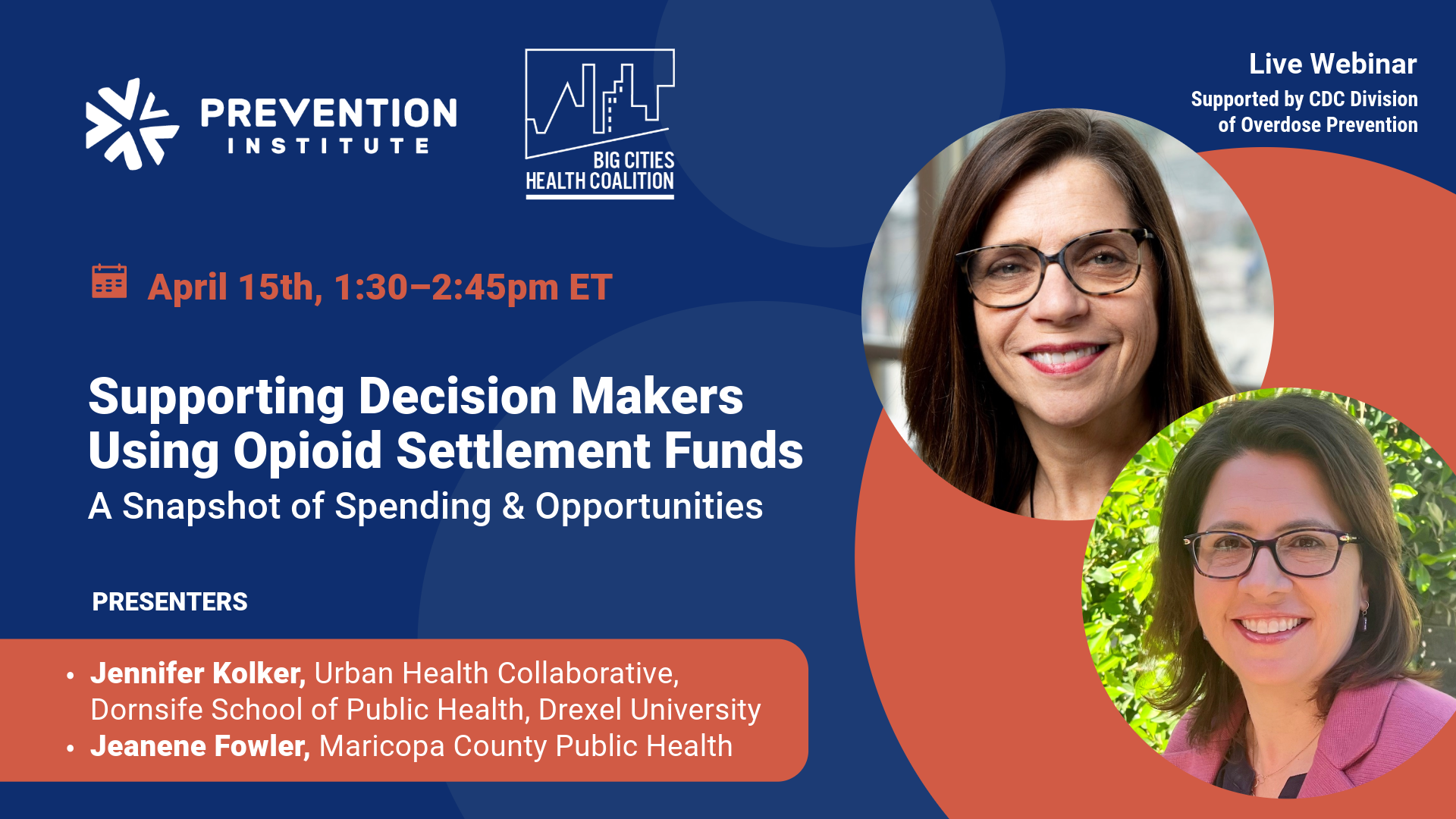
Webinar 1: A Snapshot of Spending and Opportunities (April 15, 2024)
About the Project
Over the course of several years, an expected $50 billion will be awarded to state and local jurisdictions and more than $1.5 billion to tribal communities across the United States to address the consequences of the opioid epidemic, including rising overdose deaths and the spread of infectious diseases associated with substance use.
In 2023, Prevention Institute received funding from the Centers for Disease Control and Prevention to lead the project “Supporting Local Governments Using Opioid Settlement Funds on Evidence-Based Programs,” which is continuing for a second year under Big Cities Health Coalition (BCHC)’s leadership. Through this project, Prevention Institute, BCHC, and their partners – including ChangeLab Solutions, RTI International, and SheRay’s & Associates, LLC – seek to provide technical assistance and capacity building to state and local government officials to identify, select, and fund evidence-based strategies through opioid settlement dollars to prevent substance misuse, overdose, and death, and reduce the consequences of substance use more generally.
Prevention Institute and BCHC encourages jurisdictions to complement harm reduction, treatment, and recovery services with primary prevention strategies and solutions that address changes at the community level that are intended to reduce substance exposure and use in the first place.
This set of online resources is intended to offer guidance to policymakers, health departments, community advocates, service providers, and other changemakers as they consider policies and programming to establish using opioid settlement dollars. This site presents planning, implementation, and evaluation strategies that are supported by evidence and actively implemented by practitioners in the field, as well as background information on the opioid settlements. These resources, which were first compiled in July of 2024 and will be continuously updated in the project’s second year, are not meant to be comprehensive, but rather, a starting point for continued research, conversation, and planning.
This project is supported by Cooperative Agreement Number NU38OT000305 and NU38PW000033 from the Centers for Disease Control and Prevention of the U.S. Department of Health and Human Services (HHS). Please note that the views and opinions expressed in the resources included on this site are those of the authors and publishing institutions and do not necessarily represent the official views of, nor serve as an endorsement by, the Centers for Disease Control and Prevention, U.S. Department of Health and Human Services, Prevention Institute, BCHC and the aforementioned project partners.

